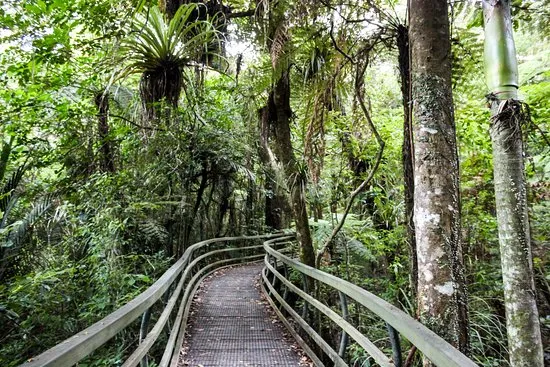Puketi Forest: Ancient Kauri Wonderland
Experience the magic of ancient kauri trees just 25 minutes from Kerigold Chalets. Day walks and night adventures await in this pristine native forest.
Quick Navigation
Essential Info
- Location: 25 mins from Kerikeri
- Walking tracks: 15 mins to 4 hours
- Night tours: Booking essential
- Best time: Year-round
Every time I drive into Puketi Forest, I feel like I'm entering another world. As a Kerikeri local who's spent countless weekends exploring this ancient forest, it's one of Northland's true treasures. Standing beneath the massive kauri trees that have been here for over 1,000 years gives you a sense of perspective that's hard to find anywhere else.
Puketi is part of the same forest system as the more famous Waipoua (home to Tāne Mahuta), but it's less crowded and, in my opinion, offers a more intimate experience with these ancient giants. Just a 25-minute drive from Kerigold Chalets, it makes for a perfect half-day or full-day adventure during your stay in Kerikeri.
Getting There
Puketi Forest is easily accessible from Kerikeri, and the drive itself is part of the experience:
Directions from Kerigold Chalets
Head north on Kerikeri Road, then turn left onto State Highway 10. After about 10 minutes, turn right onto Puketi Road (look for the brown tourist sign). Follow this road for approximately 15 minutes until you reach the Puketi Forest Headquarters and main car park.
Total driving time: About 25 minutes (22km)
Road conditions: The last part is gravel but well-maintained and suitable for all vehicles
Local Tip
There's no cell phone coverage in most of the forest, so I always recommend downloading offline maps before you go.
Day Walks
Puketi Forest offers several walking tracks suitable for different fitness levels and time frames. Here are my favorites:
Puketi Nature Trail (15-30 minutes)
This is the perfect introduction to the forest if you're short on time or have young children. It's a flat, easy loop track that takes you through beautiful native bush with information panels explaining the forest ecosystem. I often bring visitors here first to get them acquainted with our native plants before heading to the more impressive tracks.
Kauri Walkway (1 hour)
This is my absolute favorite walk in Puketi. The elevated boardwalk takes you through a grove of ancient kauri trees, some estimated to be over 1,000 years old. The boardwalk design protects the sensitive kauri roots from foot traffic and helps prevent the spread of kauri dieback disease. The massive trunks of these giants are awe-inspiring, and the forest canopy high above creates a cathedral-like atmosphere.
Puketi Ridge Track (4 hours return)
For more adventurous hikers, this track offers spectacular views across the forest canopy. It's more challenging with some steep sections, but the panoramic vistas are worth the effort. On clear days, you can see all the way to the Bay of Islands.
Kauri Dieback Prevention
I'm passionate about protecting these ancient trees. Always use the boot cleaning stations at the track entrances and exits. Clean your footwear thoroughly to remove all soil that might carry the microscopic spores of kauri dieback disease. Stay on the marked tracks and boardwalks at all times.
Night Adventures
Puketi Forest truly comes alive after dark, offering some of the most magical experiences in Northland:
Glowworm Walks
One of my favorite things to do is take friends on a guided night walk to see the glowworms. These tiny creatures create a stunning display that looks like a galaxy of blue-green stars in the darkness of the forest. Several local operators run evening tours, and they know exactly where to find the best glowworm displays.
The best spots are along stream banks and in small gullies, where the glowworms hang from overhanging vegetation. It's a truly magical experience and something many visitors to New Zealand miss out on.
Kiwi Listening Walks
Puketi is home to the North Island brown kiwi, and while these shy birds are rarely seen, their distinctive calls can often be heard after dark. Some tour operators offer kiwi listening experiences where you can sit quietly in the forest and listen for their calls. I've been lucky enough to hear kiwi calling on several occasions, and it's an experience I never tire of.
Night Walk Tips
- Book guided night walks in advance - they're popular and often sell out
- Wear warm clothing even in summer - the forest gets cool at night
- Bring a red-light torch if you have one (less disruptive to wildlife)
- Speak quietly and move slowly to increase your chances of wildlife encounters
Wildlife Spotting
Puketi Forest is a biodiversity hotspot, home to many native species. Here's what to look out for:
- North Island Brown Kiwi: Rarely seen but sometimes heard at night
- Kauri Snails: These large native snails are sometimes spotted on damp nights
- Native Birds: Listen for the distinctive calls of tūī, kererū (wood pigeon), and fantails
- Hochstetter's Frogs: One of our most ancient frog species lives in the streams
- Kauri Trees: Some specimens are over 1,000 years old and 30+ meters tall
Photography Tips
The dappled light through the forest canopy makes photography challenging but rewarding. I find early morning offers the best light, especially when the sun's rays filter through the mist that often hangs in the forest. Bring a tripod for low-light conditions, and a wide-angle lens to capture the massive scale of the kauri trees.
Frequently Asked Questions about Puketi Forest
Experience Puketi Forest During Your Stay
Stay at Kerigold Chalets and explore Puketi Forest and other natural wonders from our central Kerikeri location.
